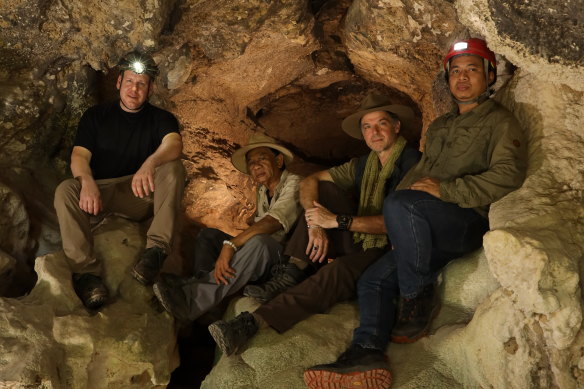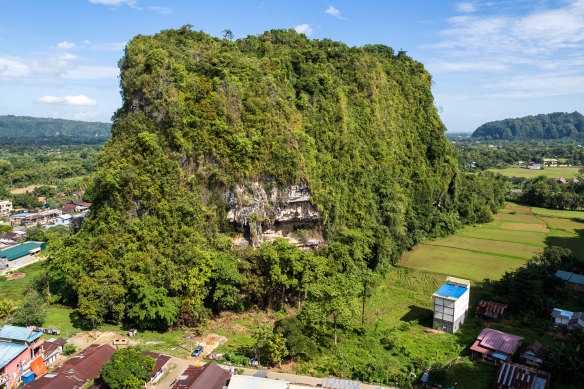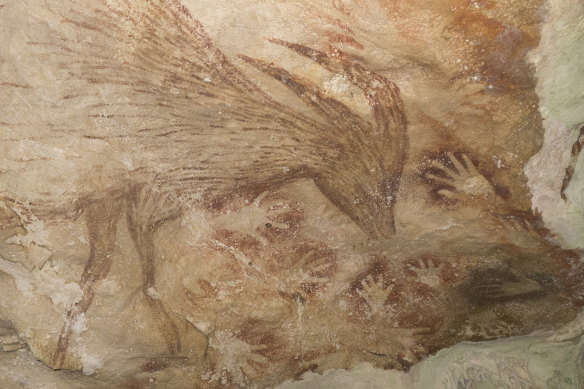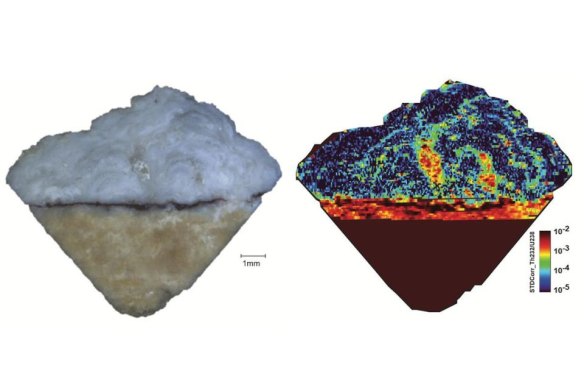This was published 6 months ago
Inside the cave where Australians have uncovered the world’s oldest rock art
By Angus Dalton
Australian archaeologists have uncovered humanity’s oldest-known rock art, and the prehistoric tableau of a warty pig and three stick figures may also be the earliest-ever depiction of a story.
The scientists used a new dating method to analyse knots of calcium carbonate that have solidified over the painting within a limestone cave on the Indonesian island of Sulawesi. The art they discovered is at least 51,200 years old.
“The painting is a narrative composition, a composed scene, depicting three human-like figures interacting with a pig, so it’s the earliest evidence identified for the use of storytelling in art,” said Adam Brumm, a professor of archaeology at Griffith University and co-author of the Nature paper reporting the findings.
The same research team challenged Europe as the custodian of the world’s oldest cave art in 2014 by revealing paintings in the Sulawesi caves were at least 40,000 years old, rivalling the antiquity of charcoal drawings in Spain and France.
Now they’re sure this cave painting is by far the oldest art ever discovered. It’s about triple the age of Australia’s earliest cave painting, a 17,300-year-old red ochre kangaroo in the Kimberley.
Another significant Sulawesi cave painting the researchers analysed depicts a gang of “therianthropes”, which are figures that combine features of animals and humans.

Members of the research team (left to right) Maxime Aubert, Budianto Hakim, Adam Brumm and Adhi Agus Oktaviana.Credit: Ratno Sardi
At least 48,000 years ago, ancient artists drew these humans and added what appear to be beaks and tails – leaving behind some of the oldest evidence of creativity.
“Archaeologists are very interested in depictions of therianthropes because it provides evidence for the ability to imagine the existence of a supernatural being, something that does not exist in real life,” Brumm said.
“Storytelling is a hugely important part of human evolution and possibly even helps to explain our success as a species, but finding evidence for it in art, especially in very early cave art, is exceptionally rare.”
Over centuries, water has trickled over the Sulawesi cave paintings and left behind layers of calcium carbonate that hold uranium molecules: a molecular stopwatch that decays at a steady rate, allowing scientists to date ancient minerals.

Leang Karampuang, a dramatic karst hill in Sulawesi, Indonesia, riddled with caves that host the world’s oldest rock art.Credit: BRIN Google Arts & Culture

Other cave paintings from Sulawesi date back 40,000 years.Credit: Adam Brumm
Two Australian experts in archaeogeochemistry, professors Maxime Aubert and Renaud Joannes-Boyau, developed a new way of dating these carbonate layers, which doesn’t form in neat sheets but rather tiny nodules resembling popcorn.
The scientists used a laser to vaporise fragments of rock eight times thinner than hair. Analysis of the tiny vaporised samples allowed the archaeologists to determine which layer was closest to the pigment and estimate how long ago humans applied their red strokes to the wall.
Aubert said the technique would “revolutionise rock art dating”.

Sample cross-sections show the pigment layer (the stripe running through the middle of the sample), the limestone wall beneath and the calcium carbonate formations on the pigment.Credit: Nature
Humans have been telling stories for much longer than 51,200 years, said Adhi Agus Oktaviana, the rock art expert who led the research.
“But as words do not fossilise, we can only go by indirect proxies like depictions of scenes in art – and the Sulawesi art is now the oldest such evidence by far that is known to archaeology.”
The Examine newsletter explains and analyses science with a rigorous focus on the evidence. Sign up to get it each week.